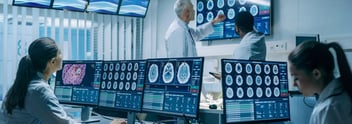Why Is It So Difficult To See a Doctor?
Despite consistently high numbers of confirmed cases across the UK, life has been getting back to normal over the past few months. Shops, pubs and restaurants are open once more, and thriving. Public transport is creeping back to pre-pandemic levels, and cities are becoming busier as people return to office working. One area of society that isn’t operating normally, however, is the NHS.
The BMA describes the current situation faced by the NHS as the most severe in its 70 year history. There is significant strain evident in all aspects of the health service and the confluence of pressures are impacting both NHS staff and members of the public.
Members of the Public are:
-
Frustrated they can’t get an appointment quickly
-
Expecting a return to face-to-face appointments
-
Experiencing long waiting lists for treatment
-
Having scheduled surgery cancelled
-
Waiting for hours in A&E
-
Seeing stacked-up ambulances outside hospitals
NHS Staff are:
- Dealing with a backlog of over 5 million
- Continuing with COVID-19 regulationsStill treating COVID and NON-COVID patients
- Managing a depleted workforce (burnout, retirement, leaving NHS)
- Experiencing the fallout of 18 months of managing crisis
- Receiving negative press in some media outlets
LDA Research Talks to Doctors About Their Experiences
We’ve been carrying out research into the ‘bottlenecks in the system’ that are causing particular strain on NHS staff. The LDA team talked to surgeons and GPs about the systemic pressures they’re experiencing daily, and the impact these have on patients waiting for treatment. Whilst the strain for GPs is different than that experienced by surgical staff, it's clear that the interconnectedness of the parts leads to a ‘grinding of gears’ across the entirety of the organisation.
The Surgeon’s Perspective
“Things are a lot slower, because…nothing is kept inside the OR any more, so the runner has to go in and out, use special corridors so that they don't contaminate certain areas. So really it's about the workflow that is a lot slower in terms of procuring things and getting things ready.”
- Consultant Neurosurgeon in London
All NHS hospitals in the UK remain divided between care for COVID and NON-COVID patients. This, in itself, creates limited capacity for NON-COVID surgery, and a new set of procedures that slow down the work of the operating theatre. We have selected 5 key examples of ways in which the pre-COVID procedures of the NHS continue to be compromised by COVID-19 care.
Patients need to take a COVID test 3 days before elective surgery. If they test positive the surgery is rescheduled. Pre-pandemic their place would have been taken by another patient on the waiting list. This is no longer possible due to the requirement to test, so surgical slots get wasted.
The operating theatre has to be deep cleaned after each COVID or emergency procedure, which limits the amount of work that can be done each day. PPE preparation has to be factored into the time a procedure will take, and equipment has to be fetched by a runner, all of which slows down the speed at which you can work.
The PPE staff are required to wear when dealing with COVID patients is heavy, unwieldy and claustrophobic. Carrying out surgery wearing PPE makes regular breaks a necessity. PPE has to be changed multiple times if moving between RED and GREEN areas of the hospital.
One surgeon we spoke to commented not only on the incessant strain placed on NHS staff, but also the low morale they’re now experiencing:
“There is still a huge strain in the NHS with the capacity versus demand. This in addition to a huge backlog accumulated through the pandemic. Staff are extremely tired, and that's the whole NHS, not just me as a surgeon, but all staff who have been through Covid.
Now it's like right… ’thanks very much for that, now we've got to get back and work even harder to get the backlog done.’
That's quite a big ask, for people. You can chuck money at it, and chuck money at it as sort of a short-term thing, but at the end of the day, people value other things more than money.”
- Jeremy Jules French, Consultant HPB, Sarcoma and Transplant Surgeon
The GP’s Perspective
“There is far too much demand for primary care services at the moment and not enough workforce or money invested in general practice to meet this demand which is growing both in volume and complexity.”
- Dr Jassim
Since August 2021 GPs have faced increasingly negative press in some sectors of the media. They have been accused of ‘hiding behind their Zoom screens’ and of ‘ignoring orders to allow patients face-to-face appointments’. There's clear evidence however, that many practices are offering patients a choice of whether to see their doctor face-to-face, or by phone or screen, and there is no doubt that GP practices are struggling:
“We are managing 90% of NHS workload for a mere 10% of NHS budget. There is a national shortage of GPs and on average there is only 1 full time GP for 2200 patients and our population is continuously growing but unfortunately the number of GPs is continuously falling. Staff were at a full stretch before the pandemic. They are now in large exhausted and demoralised.”
- Dr Jassim
The issues which GPs report as being critical to their ongoing care of patients are:
- Unsustainable workloads
- Poor practice premises
- Huge care backlog
- Inappropriate transfer of work from secondary care
- Increasing abuse from the public fuelled by unhelpful media headlines
NHS Digital GP workforce data shows that the GP workforce has shrunk by 1,803 since 2015. Many GPs find themselves regularly working 12 hour days simply to keep up with their workload. This is set against the context of an ageing population which is increasing the demand on GP practices.
The solution to a creaking GP service in the UK is, in part, better funding for improved practices, and more staff. However GPs told us that more effective communication was needed between different parts of the NHS, and less bureaucracy. If the NHS is to continue to operate effectively they recommend a re-alignment of the GPs role. This shift in public awareness would require:
- Public health education on self-care
- Use of resources such as pharmacies and allied healthcare professionals
- Health promotion and leadership
About LDA Research
LDA Research is an international qualitative research provider. Set up in 2011 by Lucy Doorbar, the LDA team specialises in providing global intelligence in the pharmaceutical industry and medical device sector. We have a network of international associates as well as dedicated healthcare panels in the UK and US. The LDA team can be your eyes and ears wherever you need it to be.



